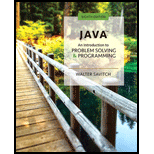
Explanation of Solution
a.
Method heading for each method:
- Method heading for project rating is “public void rateProject()”.
- Method heading for total rating is “public int totalRating()”...
Explanation of Solution
b.
Preconditions and postconditions of each method:
- Precondition and postcondition of “public void rateProject()” method.
- Precondition: None.
- Postcondition: Ratings were attained from user for each category and then assign it to the variable.
- Precondition and postcondition of “totalRating()” method.
- Precondition: None.
- Postcondition: This method returns total rating for each category...
Explanation of Solution
c.
Java statement for testing the class:
//Create an object for "ScienceFairProjectRating" class
ScienceFairProjectRating joesProject = new ScienceFairProjectRating();
ScienceFairProjectRating suesProject = new ScienceFairProjectRating();
//Call "initialize()" method to initialize the variables
joesProject.initialize("Weather and You", "U1256", "Joe Minnow");
suesProject...
Explanation of Solution
d.
Implementation of class:
ScienceFairProjectRating.java:
//Import the java package
import java.util.Scanner;
//Define the class
public class ScienceFairProjectRating
{
//Declare the required variables
private String projectName;
private String identifier;
private String submitter;
//Create an object for "RatingScore" class
private RatingScore creativeRating;
private RatingScore thoughtRating;
private RatingScore thoroughnessRating;
private RatingScore technicalRating;
private RatingScore clarityRating;
//Define the "initialize()" method
public void initialize(String name, String id, String person)
{
//Initialize the required variables
projectName = name;
identifier = id;
submitter = person;
creativeRating = new RatingScore();
thoughtRating = new RatingScore();
thoroughnessRating = new RatingScore();
technicalRating = new RatingScore();
clarityRating = new RatingScore();
creativeRating.initialize("How creative was this project", 30);
thoughtRating.initialize("Was scientific thought displayed in the project", 30);
thoroughnessRating.initialize("Did the project cover the material thoroughly", 15);
technicalRating.initialize("Were appropriate technical skill displayed", 15);
clarityRating.initialize("Was the presentation of the project clear", 10);
}
//Define the "rateProject()" method
public void rateProject()
{
//Display the message to get the rating
System.out.println("Please enter ratings for the project " + projectName + "(" + identifier + ")");
/*Call "inputRating()" method using objects of RatingScore class. */
creativeRating.inputRating();
thoughtRating.inputRating();
thoroughnessRating.inputRating();
technicalRating.inputRating();
clarityRating.inputRating();
}
//Define the "totalRating()" method
public int totalRating()
{
//Calculate the total rating and then return it
return creativeRating.getRating() + thoughtRating.getRating() + thoroughnessRating.getRating() + technicalRating.getRating() + clarityRating.getRating();
}
//Define the "maxRating()" method
public int maxRating()
{
//Calculate the maximum rating and then return it
return creativeRating.getMaxRating() + thoughtRating.getMaxRating() + thoroughnessRating.getMaxRating() + technicalRating.getMaxRating() + clarityRating.getMaxRating();
}
//Define the "getRatingString()" method
public String getRatingString()
{
//Calculate the project rating and then return it
return "Project " + projectName + "(" + identifier + ") by " + submitter + " was given the score "
+ totalRating() + "/" + maxRating();
}
//Define the "main()" method
public static void main(String[] args)
{
/*Create an object for "ScienceFairProjectRating" class. */
ScienceFairProjectRating joesProject = new ScienceFairProjectRating();
ScienceFairProjectRating suesProject = new ScienceFairProjectRating();
/*Call initialize() method to initialize the variables. */
joesProject.initialize("Weather and You", "U1256", "Joe Minnow");
suesProject.initialize("Hot Air", "U1275", "Susan Shark");
//Call "ratePorject()" to rate the project
joesProject.rateProject();
suesProject.rateProject();
System.out.println("Judging is completed: ");
/*Call "getRatingString()" method to get the project rating. */
System.out.println(joesProject.getRatingString());
System.out.println(suesProject.getRatingString());
}
}
RatingScore.java:
//Import the java package
import java.util.Scanner;
//Define the class
public class RatingScore
{
//Declare the required variables
private String description;
private int maximumRating;
private int theRating;
//Define the "initialize()" method
public void initialize(String desc, int max)
{
//Initialize the required variables
description = desc;
maximumRating = max;
theRating = -1;
}
//Define "inputRating()" method
public void inputRating()
{
//Read the maximum rating value from user
System...
Want to see the full answer?
Check out a sample textbook solution
Chapter 5 Solutions
Java: An Introduction to Problem Solving and Programming (8th Edition)
- Draw an ERD that represents a book in a library system. Be sure to add relationship types, key attributes, attributes and multiplicity on the ERD.arrow_forward2:21 m Ο 21% AlmaNet WE ARE HIRING Experienced Freshers Salesforce Platform Developer APPLY NOW SEND YOUR CV: Email: hr.almanet@gmail.com Contact: +91 6264643660 Visit: www.almanet.in Locations: India, USA, UK, Vietnam (Remote & Hybrid Options Available)arrow_forwardProvide a detailed explanation of the architecture on the diagramarrow_forward
- hello please explain the architecture in the diagram below. thanks youarrow_forwardComplete the JavaScript function addPixels () to calculate the sum of pixelAmount and the given element's cssProperty value, and return the new "px" value. Ex: If helloElem's width is 150px, then calling addPixels (hello Elem, "width", 50) should return 150px + 50px = "200px". SHOW EXPECTED HTML JavaScript 1 function addPixels (element, cssProperty, pixelAmount) { 2 3 /* Your solution goes here *1 4 } 5 6 const helloElem = document.querySelector("# helloMessage"); 7 const newVal = addPixels (helloElem, "width", 50); 8 helloElem.style.setProperty("width", newVal); [arrow_forwardSolve in MATLABarrow_forward
- Hello please look at the attached picture. I need an detailed explanation of the architecturearrow_forwardInformation Security Risk and Vulnerability Assessment 1- Which TCP/IP protocol is used to convert the IP address to the Mac address? Explain 2-What popular switch feature allows you to create communication boundaries between systems connected to the switch3- what types of vulnerability directly related to the programmer of the software?4- Who ensures the entity implements appropriate security controls to protect an asset? Please do not use AI and add refrencearrow_forwardFind the voltage V0 across the 4K resistor using the mesh method or nodal analysis. Note: I have already simulated it and the value it should give is -1.714Varrow_forward
 C++ Programming: From Problem Analysis to Program...Computer ScienceISBN:9781337102087Author:D. S. MalikPublisher:Cengage Learning
C++ Programming: From Problem Analysis to Program...Computer ScienceISBN:9781337102087Author:D. S. MalikPublisher:Cengage Learning EBK JAVA PROGRAMMINGComputer ScienceISBN:9781337671385Author:FARRELLPublisher:CENGAGE LEARNING - CONSIGNMENTProgramming Logic & Design ComprehensiveComputer ScienceISBN:9781337669405Author:FARRELLPublisher:Cengage
EBK JAVA PROGRAMMINGComputer ScienceISBN:9781337671385Author:FARRELLPublisher:CENGAGE LEARNING - CONSIGNMENTProgramming Logic & Design ComprehensiveComputer ScienceISBN:9781337669405Author:FARRELLPublisher:Cengage Microsoft Visual C#Computer ScienceISBN:9781337102100Author:Joyce, Farrell.Publisher:Cengage Learning,
Microsoft Visual C#Computer ScienceISBN:9781337102100Author:Joyce, Farrell.Publisher:Cengage Learning, C++ for Engineers and ScientistsComputer ScienceISBN:9781133187844Author:Bronson, Gary J.Publisher:Course Technology Ptr
C++ for Engineers and ScientistsComputer ScienceISBN:9781133187844Author:Bronson, Gary J.Publisher:Course Technology Ptr Programming with Microsoft Visual Basic 2017Computer ScienceISBN:9781337102124Author:Diane ZakPublisher:Cengage Learning
Programming with Microsoft Visual Basic 2017Computer ScienceISBN:9781337102124Author:Diane ZakPublisher:Cengage Learning





